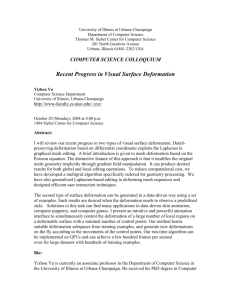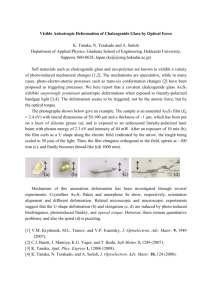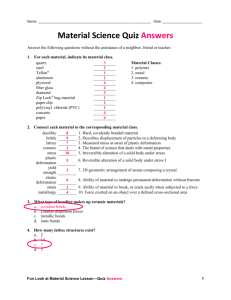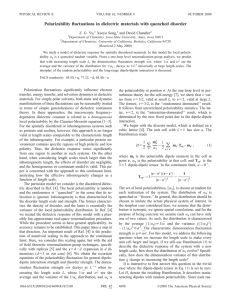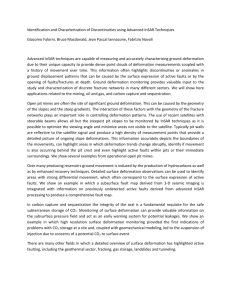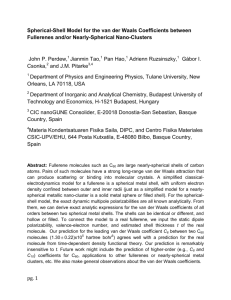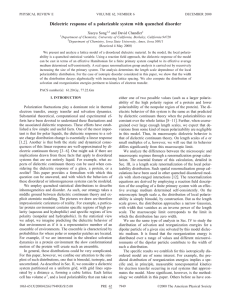Molecular Polarizability of Carbon Nanotube
advertisement
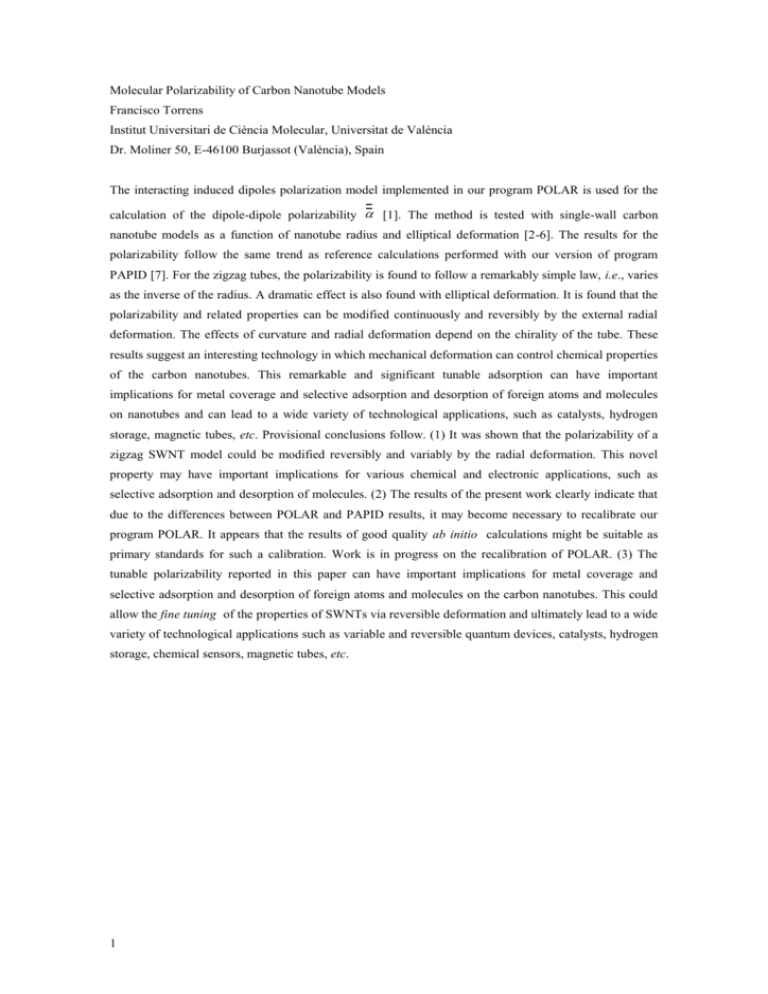
Molecular Polarizability of Carbon Nanotube Models Francisco Torrens Institut Universitari de Ciència Molecular, Universitat de València Dr. Moliner 50, E-46100 Burjassot (València), Spain The interacting induced dipoles polarization model implemented in our program POLAR is used for the calculation of the dipole-dipole polarizability [1]. The method is tested with single-wall carbon nanotube models as a function of nanotube radius and elliptical deformation [2-6]. The results for the polarizability follow the same trend as reference calculations performed with our version of program PAPID [7]. For the zigzag tubes, the polarizability is found to follow a remarkably simple law, i.e., varies as the inverse of the radius. A dramatic effect is also found with elliptical deformation. It is found that the polarizability and related properties can be modified continuously and reversibly by the external radial deformation. The effects of curvature and radial deformation depend on the chirality of the tube. These results suggest an interesting technology in which mechanical deformation can control chemical properties of the carbon nanotubes. This remarkable and significant tunable adsorption can have important implications for metal coverage and selective adsorption and desorption of foreign atoms and molecules on nanotubes and can lead to a wide variety of technological applications, such as catalysts, hydrogen storage, magnetic tubes, etc. Provisional conclusions follow. (1) It was shown that the polarizability of a zigzag SWNT model could be modified reversibly and variably by the radial deformation. This novel property may have important implications for various chemical and electronic applications, such as selective adsorption and desorption of molecules. (2) The results of the present work clearly indicate that due to the differences between POLAR and PAPID results, it may become necessary to recalibrate our program POLAR. It appears that the results of good quality ab initio calculations might be suitable as primary standards for such a calibration. Work is in progress on the recalibration of POLAR. (3) The tunable polarizability reported in this paper can have important implications for metal coverage and selective adsorption and desorption of foreign atoms and molecules on the carbon nanotubes. This could allow the fine tuning of the properties of SWNTs via reversible deformation and ultimately lead to a wide variety of technological applications such as variable and reversible quantum devices, catalysts, hydrogen storage, chemical sensors, magnetic tubes, etc. 1 140 Molecular polarizability (Å 3 ) 120 100 1276.932x 3 198.035x2 y= + 110.714 r = 0.999 + 14.034x Ref. 80 60 y = 139.159x 3 - 48.928x2 + 3.961x + 33.741 r = 0.980 40 0 0.1 0.2 0.3 yy Figure 1. Variation of the molecular polarizability of a 8,0 zigzag SWNT model as a function of the elliptic radial deformation, yy. [1] F. Torrens, J. Sánchez-Marín and I. Nebot-Gil, J. Mol. Struct. (Theochem) 463 (1999) 27. [2] A. Rochefort, P. Avouris, F. Lesage and D. R. Salahub, Chem. Phys. Lett. 297 (1998) 45. [3] C. J. Park, Y. H. Kim and K. J. Chang, Phys. Rev. B 60 (1999) 10656. [4] Ç. Kiliç, S. Ciraci, O. Gülseren and T. Yildirim, Phys. Rev. B 62 (2000) R16345. [5] O. Gülseren, T. Yildirim, S. Ciraci and Ç. Klç, Phys. Rev. B 65 (2002) 155410. [6] O. Gülseren, T. Yildirim and S. Ciraci, Phys. Rev. B 65 (2002) 153405. [7] F. Torrens, J. Phys. Org. Chem., in press. 2


